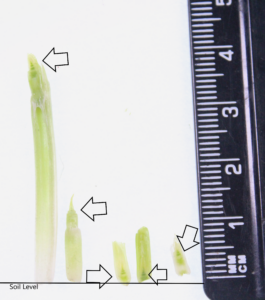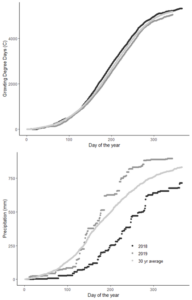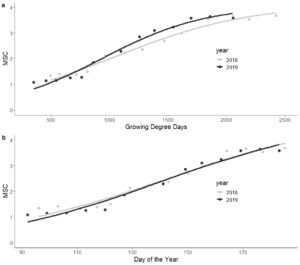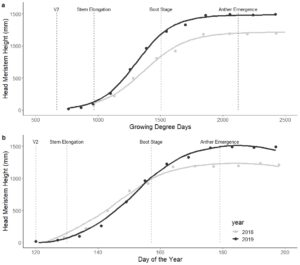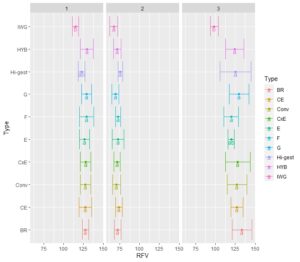Final report for GNC18-253
Project Information
Kernza®, the perennial grain domesticated from intermediate wheatgrass (Thinopyrum intermedium), is a viable dualpurpose forage and grain crop for diversified farming operations. Commercialization of Kernza has already begun, but research is needed to ensure farmers can grow it profitably on a larger scale while bringing its environmental benefits to farmers, consumers, and the land. One possible way to achieve greater ecological intensification and profitability with Kernza is to plant it in bicultures with legumes to reduce or eliminate synthetic nitrogen requirements and increase the forage quantity and quality produced.
Alfalfa is the most productive and familiar forage legume for many farmers and is likely the most adapted species for Kernza+legume bicultures in Kansas. Therefore, this project will compare grain yields, forage yields, and forage quality of Kernza monocultures and Kernza+alflalfa bicultures planted with multiple alfalfa varieties and managed as a dual-purpose forage and grain crop. Agronomic knowledge gained through this project will be incorporated into a Kernza Growers
Guide being developed by the larger Kernza farmer and researcher community.
Specific outputs of this project to be included in the guide are: a Kernza Crop Calendar that helps Kansas farmers utilizing growing degree days to predict Kernza growth stages and the appropriate times to graze, hay, or harvest grain from their fields; recommendations of compatible alfalfa varieties and/or germplasm types that optimize the balance between maintaining or increasing Kernza grain yields and forage production/quality while reducing the needs for nitrogen fertilizer applications; and ecological knowledge about the soil health impacts of Kernza and Kernza+alfalfa cropping systems, including changes in the soil organic nitrogen pool and nitrogen mineralization rates.
Knowledge and results generated from this project will also be disseminated to farmers, researchers, and other audiences by hosting a farmer field day, through presentations at The Land Institute Prairie Festival, publication online, and through peer-reviewed publication in scientific journals. The ability of the proposed research and planned educational activities to assist and influence farmers growing or interested in growing Kernza and Kernza+alfalfa bicultures will be evaluated by
tracking attendance at outreach events, using surveys to judge the levels of knowledge gained by farmers at the events and monitoring the increase in the number of acres planted to Kernza and intercropped Kernza in Kansas and the North Central SARE region.
Learning outcomes. Agronomic knowledge about the timing of important morphological stages of Kernza development when grown in monocultures under varying plant densities and fertilization rates and in bicultures with alfalfa. Awareness of the effects of alfalfa variety and germplasm types on Kernza+alfalfa compatibility in biculture cropping systems. Ecological knowledge of the potential changes in soil health properties by growing perennial crops such as Kernza, in monocultures or mixtures with legumes. Increased farmer awareness perennial species as viable crops within a long-term holistic management strategy. Training of a master's student in sustainable agriculture principles and emerging technologies and production practices.
Action outcomes. Increase in farmed acres of Kernza in Kansas and the North Central Region (NCR). Incorporation of alfalfa as a companion species to limit the use of synthetic nitrogen fertilizers in Kernza fields and to fortify residues grazed or hayed on those acres. Selection of specific alfalfa germplasm types adapted to farmers' growing regions that are compatible with Kernza. Incorporation of Kernza growth and development in response to growing degree day accumulation into a Kernza crop calendar made available to farmers through a Kernza grower guide. Increased consumer demand and processor preference for Kernza sourced from farmers that use sound ecological principles, such as Kernza+alfalfa intercropping, on their farms. Inspiration of new research and breeding strategies to increase compatibility of Kernza and alfalfa germplasm when grown in bicultures.
Research
Objective 1: Develop Kernza Crop Calendar when grown in monoculture and mixed plantings with alfalfa.
Site and establishment
The experimental design was a split-split plot randomized complete block with four replications where the main plot was cropping system, split plot was year (stand age) and split-split plot was weekly clippings. There were eight total main-plot cropping systems: four monoculture IWG and four IWG+alfalfa intercropping systems. The four monoculture IWG cropping systems included fertilized (IWGn+fert) and unfertilized (IWGn) IWG seeded in narrow rows (30.5 cm) and fertilized (IWGw+fert) and unfertilized (IWGw) IWG seeded in wide rows (61 cm). The four intercropping systems were IWG seeded in alternating rows (30.5 cm) with each of the four alfalfa varieties previously described. `Agate`, `Ineffective Agate `, `AFXexp`, and `Hybriforce3400` (IWG+Agate; IWG+AgateInef; IWG+AFXexp; IWG+Hybriforce3400). IWGw+fert and IWGn+fert plots received 174 kg ha-1 broadcasted urea (46-0-0) during the second year in March 2019. The IWG+alfalfa binary plots were not fertilized.
A 15 cm clipping was taken from a single IWG row per plot at a height of 3.8 cm above the soil surface each week from the first week of April through the hard dough stage in mid-July. Clippings were taken sequentially within the rows to avoid collecting regrowth from previously clipped areas. Five IWG tillers from each clipping were randomly selected during the early spring vegetative stages while five random reproductive tillers were selected during and after elongation stages (Jungers et al., 2018). For each tiller, i) the growth index stage was recorded until anthesis according to the growth index staging criteria of Moore et al. (1991) and used to calculate the mean stage count (MSC) of the plot and ii) the head meristem height (HMH) was measured from the cutting point above the soil to the apical HM.
Prior to inflorescence emergence, tillers were dissected to measure HMH (Figure 1).
Figure 1. Developing head meristems in dissected intermediate wheatgrass tillers.
Daily temperature and precipitation were recorded using a Davis Weatherlink Vantage Pro2 (Davis Instruments, Hayward, CA) approximately 2.7 km from the field site. The accumulation of heat units was monitored as the accumulated growing degree days (GDD) (Equation 1) using a base temperature of 0 ℃ (Frank et al 1996).
GDD = (Daily maximum + daily minimum (°C))/2- base temperature (°C) (1)
Daily maximum was the observed maximum temperature and daily minimum was the minimum observed temperature. When daily minimum temperature was below the base temperature, the daily minimum was set to 0 ℃. Accumulation of GDD began after five consecutive days of daily air temperature above 0 ℃ after 1 January (Mitchell et al., 1998) and ended at grain harvest.
Objective 2: Identifying Compatible Germplasm
Site and Establishment
(Same as Objective 1)
Table 1. Alfalfa selections with their seed source, fall dormancy and variety type. BR: Branch Rooted; Conv: Conventional; CxE: Conventional x European; E: European; Falcata: Yellow flowered; G: Grazing; Hi-Gest: High digestibility; HYB: Hybrid.
| Source | Fall dormancy | Type | |
| A-100 | Star Seed | 4.0 | Conv |
| AFX135021 | Alforex | 4.6 | CxE |
| AFX142001 | Alforex | 1.5 | BR |
| AFX144170 | Alforex | 3.3 | Conv |
| AFX152003 | Alforex | 2.4 | BR |
| AFX153032 | Alforex | 3.3 | E |
| AFX153037 | Alforex | - | Conv |
| AFX154022 | Alforex | 4.1 | CE |
| AFX164048 | Alforex | 4.2 | Conv |
| AFXH144110 | Alforex | 3.6 | HYB |
| Agate | Dr. Deborah Lamac | 2.0 | Conv |
| Ineffective Agate | Dr. Deborah Lamac | 2.0 | Conv |
| Amerigraze 401 + Z | Delange seed | - | G |
| WISFAL x Legacy | Dr. Edwin Bingham | - | F |
| UMN Biomass | Dr. Joan Lamb | - | Conv |
| CWA113005 | Alforex | 3.6 | Hi-gest |
| Falcata | Millborn Seed | - | F |
| FF LH.422 | La Crosse Seed | 4.0 | Conv |
| Gunner | Croplan | 4.9 | Conv |
| Hybriforce-3400 | Alforex | 4.3 | HYB |
| Ladak | Star Seed | 3.0 | Conv |
| Magnum 7 | Dairyland Seed | 4.0 | Conv |
| Pasture Plus | Millborn Seed | 3.8 | G |
| Ranger | Millborn Seed | 3.0 | Conv |
| Shuttle II | Phillips Seed | - | Conv |
| Spreador3 | Syngenta | 1.0 | BR |
Total forage yield (IWG+alfalfa) of each plot was measured at three different times during the growing season: spring, summer (straw only), and fall. A subsample will be taken at harvest, dried, sent to the University of Wisconsin, ground to pass through a 1mm screen and estimated for forage quality measures. Forage quality of the of the subsamples was estimated using NIRS curves developed for IWG+alfalfa mixtures. IWG grain was harvested and weighed at physiological maturity using a plot combine.
Objective 3: Monitor soil health properties
Soil cores were taken at a depth of 8 inches prior to planting in 2017 and following final forage harvest in the fall of 2020. Samples were sent to ServitechLabs (Dodge City, KS) for analysis. Plant root simulator (PRS) probes (Western Ag) were placed in control plots during the grain fill period of 2019.
Objective 1: Develop Kernza Crop Calendar when grown in monoculture and mixed plantings with alfalfa.
Weather
Accumulated GDD after planting totaled 1580 until the end of 2017. Monthly average daily air temperatures and monthly accumulated GDD were greater in 2018 than in 2019 for all months except January. Monthly precipitation was lower in 2018 and higher in 2019 than the 30 yr average (Figure 2).
Figure 2. Accumulation of growing degree days (℃) and precipitation (mm) for site years and 30 yr average near Salina, KS.
Growth stage and reproductive tiller development
Intermediate wheatgrass MSC differed between clippings within years (Table 3) while progressing positively in a logistic growth pattern (Figure 3, Table 4) for both yrs.
Figure 3. Response of mean stage count (MSC) as affected by a) accumulated growing degree days (GDD) and b) day of the year (DOY) for intermediate wheatgrass. Values are means across all cropping systems. Regression coefficients and residual standard errors are reported in Table 4.
|
Table 4. Coefficient estimates and residual standard error for growth responses as affected by growing degree day (GDD) or day of the year (DOY) for intermediate wheatgrass. Values were pooled across cropping systems due to no significant differences after Tukey adjustment. |
||||||
|
Function |
Year |
Independent variable |
β1 |
β2 |
β3 |
RSEa |
|
|
|
|
Mean Stage Count |
|
||
|
logisticb |
2018 |
GDD |
4.14 |
1042 |
5.82 × 102 |
0.18 |
|
|
2019 |
|
4.06 |
947 |
4.36 × 102 |
0.19 |
|
|
2018 |
DOY |
5.06 |
144 |
3.50 × 101 |
0.22 |
|
|
2019 |
|
4.72 |
140 |
3.04 × 101 |
0.20 |
|
|
|
|
Head Meristem Height |
|
||
|
|
2018 |
GDD |
1212.6 |
1365.4 |
171.6 |
134.5 |
|
|
2019 |
|
1480.9 |
1306.6 |
144.0 |
150.7 |
|
|
2018 |
DOY |
1217.2 |
144.0 |
6.916 |
134.2 |
|
|
2019 |
|
1489.1 |
151.2 |
6.887 |
149.7 |
|
|
|
|
Leaf Fraction |
|
||
|
quadraticc |
2018 |
GDD |
1.761 |
-1.26 × 10-3 |
2.51 × 10-7 |
0.07 |
|
|
2019 |
|
1.613 |
-1.32 × 10-3 |
2.88 × 10-7 |
0.14 |
|
|
2018 |
DOY |
4.061 |
-3.67 × 10-2 |
8.53 × 10-5 |
0.10 |
|
|
2019 |
|
3.126 |
-2.58 × 10-2 |
5.13 × 10-5 |
0.14 |
|
|
|
|
Stem Fraction |
|
||
|
|
2018 |
GDD |
-0.727 |
1.20 × 10-3 |
-2.70 × 10-7 |
0.08 |
|
|
2019 |
|
0.351 |
2.77 × 10-4 |
-6.23 × 10-8 |
0.05 |
|
|
2018 |
DOY |
-5.359 |
6.73 × 10-2 |
-1.90 × 10-4 |
0.08 |
|
|
2019 |
|
-0.531 |
1.25 × 10-2 |
-3.30 × 10-0 |
0.05 |
|
|
|
|
|
Head Fraction |
|
|
|
|
2018 |
GDD |
-0.327 |
4.74 × 10-4 |
-9.99 × 10-8 |
0.03 |
|
|
2019 |
|
-0.355 |
4.73 × 10-4 |
-9.49 × 10-8 |
0.03 |
|
|
2018 |
DOY |
-2.361 |
2.84 × 10-2 |
-7.77 × 10-5 |
0.03 |
|
|
2019 |
|
-1.556 |
1.72 × 10-2 |
-4.09 × 10-5 |
0.03 |
|
aResidual standard error by = β1/(1+exp((β2-x)/ β3)) cy= β1 + β2x + β3x2
|
||||||
Intermediate wheatgrass HMH differed between clippings within years (Table 3) while progressing in a positive logistic growth pattern (Figure 4, Table 4).
Figure 4. Response of head meristem height (HMH) as affected by a) accumulated growing degree days (GDD) and b) day of the year (DOY) for intermediate wheatgrass with average growth index stage to describe the development morphology. Values are means across all cropping systems. Regression coefficients are reported in Table 4.
|
Table 5. Growth stage, index, and head meristem heights (HMH) based on observed growing degree days (GDD) and day of the year (DOY) and the predicted GDD and DOY to reach the same growth stage and index using logistic equations from Table 2. HMH were estimated with observed GDD and DOY using logistic equations from Table 2. |
|||||||||
|
|
|
|
|
|
|
HMHc |
|
||
|
|
GDD |
DOY |
GDDa |
DOYa |
|
|
GDD |
DOY |
|
|
Growth Stage |
Observed |
Estimated |
|
Obs. |
Estimated |
|
|||
|
|
|
|
|
mm |
|
||||
|
2018 |
% of tillers with head meristemsd |
||||||||
|
V4 |
812 |
122 |
714 |
114 |
|
- |
46.3 |
36.89 |
- |
|
Stem elongationb |
|
|
1003 |
130 |
|
|
|
|
|
|
1st node palpable |
964 |
129 |
1060 |
132 |
|
80.5 |
107 |
96.4 |
97.5 |
|
Bootb |
|
|
1607 |
158 |
|
|
|
|
|
|
Infl. emerged |
1617 |
156 |
1679 |
160 |
|
918 |
985 |
986 |
100 |
|
Anther emerged |
2426 |
185 |
2284 |
179 |
|
1198 |
1210 |
1213 |
100 |
|
2019 |
|
||||||||
|
V2 |
761 |
120 |
619 |
111 |
|
17.7 |
32.7 |
15.8 |
16.0 |
|
V4 |
863 |
127 |
848 |
123 |
|
39.3 |
65 |
42.9 |
57.5 |
|
Stem elongationb |
|
|
934 |
131 |
|
|
|
|
|
|
1st node palpable |
958 |
134 |
977 |
133 |
|
95.3 |
120.8 |
112.0 |
81.5 |
|
Bootb |
|
|
1401 |
157 |
|
|
|
|
|
|
Infl. emerged |
1385 |
155 |
1459 |
160 |
|
963 |
937 |
943.4 |
100 |
|
Anther emerged |
2056 |
183 |
1964 |
179 |
|
1489 |
1473 |
1474 |
100 |
|
a logistic growth model bStem elongation and boot stages are not measured in the field and no observed values are presented cHMH observed is the mean height on the observed date that the plots were at the growth stage in the corresponding row. Estimated HMH are based on the GDD and DOY models using the observed GDD and DOY. d Percent tillers with heads observed on actual DOY observed. |
|||||||||
Discussion
Developing dual purpose interspecies cropping systems with IWG and alfalfa requires improved understanding of the possible interactions of spring biomass removal on summer grain production as well as the interaction of IWG at various row spacings (Canode, 1965; Hunter et al., 2020b), species × row combinations (Dick et al., 2018) and water and nutrient availability. Using the growth index staging methods of Moore et al. (1991), this study found that reproductive tiller growth and development was not affected by the cropping system but driven similarly by GDD and DOY, although a small number of cropping system effects within clippings were observed. Both GDD and DOY were accurate predictors of vegetative and early reproductive development across years, but DOY more accurately predicted late reproductive stages than GDD across years (Table 5).
Critical dual-purpose management decisions will require accurate predictions of head meristem development in IWG tiller populations. This study observed developing head meristems inside of IWG tillers during vegetative stages prior to stem elongation and onset of node development. In 2019, removal of spring IWG biomass would have removed or damaged heads in tillers that were above the cutting height as early as DOY 120 (May 6). This study produced some estimates of the total number of head meristems above cutting height at early stages of stem elongation, but high RSE for these models revealed the difficulty in accurately modelling HMH across years. Accurate models are needed for early HM development to complement in-field dissection of tillers to observe HMH in the field, which is difficult and time consuming.
Conclusions
This study looked at the first two seasons of IWG grown for Kernza® perennial grain production and provides necessary parameters for improving IWG cropping system models.
Objective 2: Identifying Compatible Germplasm
Alfalfa biomass production varied between varieties and across cutting times. Spring and Fall cuttings had greater alfalfa biomass than summer. Total plot biomass (IWG+alfalfa) (not shown) was not different among varieties across the three years of the study. Spring, summer and fall forage quality was available for 2019. Relative feed value (RFV),
RFV = (120/NDF)*(88.9-(0.779*ADF))/1.29
was greatest in the spring and fall and lowest in the summer (Figure 1).
Figure 1. Relative feed value of total plot (IWG+alfalfa) spring, summer, and fall in 2019. Comparison of means by type (see Table 1 in materials and methods) within each cutting, types with the same letter are not significantly different at the alpha = .5 level after Tukey correction. Bars indicate standard error.
Grain yields for 2018-2020 were 1106, 549 and 144 kg ha-1 respectively. There were no differences in grain yields due to treatment (alfalfa or monoculture IWG).
This study would suggest that intercropping IWG with alfalfa would not reduce the overall yearly grain yields and can increase the seasonal forage quality in the spring and fall compared to monoculture IWG.
Objective 3: Monitor soil health properties
Timely understanding of soil properties and nutrient mobility is hard to achieve through standard soil tests. Plant root simulators hold promise in capturing the soil's cation release to the plants during critical growth periods. Probes with anion and cation capturing films were buried in June during the final 30 days of grain development (anthesis through grain fill). These probes capture ions from nitrate, ammonium, phosphorus, potassium and micro nutrients. No significant difference was found between plots for rate of uptake due to treatment. Rather, the likely differences were from soil water content. As a root needs moisture to absorb ions, these films also need consistent soil contact through a water film. June and July are the hottest months of the production cycle and likely caused variation in soil water content as this was a non-irrigated trial. Table 4 shows the large variation in Nitrate uptake rates (micrograms per 10cm2 per 31 days).
| Table 4. Summary statistics of Plant Root Simulator probes (Western AG) soil Nitrate (NO3-N) when buried for 31 days prior to grain harvest (2019). | ||||||
| Treatment | NO3-N1 | std | LCL | UCL | Min | Max |
| afx142001 | 89.31a | 83.26673 | 42.11548 | 136.5045 | 8.06 | 186.04 |
| hybriforce3400 | 20.57a | 10.41493 | -33.9255 | 75.06553 | 8.6 | 27.56 |
| k12fert | 68.84a | 58.30574 | 21.64548 | 116.0345 | 17.44 | 129.72 |
| k12unfert | 13.06a | 11.06173 | -34.1345 | 60.25452 | 5.48 | 29.5 |
| k24fert | 28.965a | 15.02197 | -18.2295 | 76.15952 | 9.54 | 41.14 |
| k24unfert | 27.81a | 24.26006 | -19.3845 | 75.00452 | 6.22 | 52.54 |
|
1. (μg 10 cm−2 31 d−1) a not significant std Standard deviation LCL lower confidence limit UCL upper confidence limit |
||||||
Soil samples prior to this project were taken in fall of 2018 and again in the fall of 2020 after the final haying event at a depth of 8 inches. Initial soil properties were high to very high in P and K and very low in N. Soil OM%, pH, available P (ppm), and K (ppm) remained constant. Soil Nitrate N was reduced from an average of 32 ppm prior to sowing to 3.9 ppm after the first full season. Soil N after the final year was an average of 2.1 ppm. These results suggest that IWG and IWG+alfalfa cropping systems can maintain OM levels in the topsoil but significantly reduce the available nitrate in soil in the presence of sufficient P and K.
Table 2. Soil properties for 2017-2020 production years. Plots were established after 2017 soil samples were taken in fall 2017.
|
Block |
OM % |
pH |
P (Weak Bray ppm) |
K ppm |
Nitrate-N ppm |
|
2017 |
|||||
|
1 |
2.0 |
7.3 |
16.0 |
419 |
32 |
|
2 |
1.9 |
7.2 |
15.0 |
368 |
29 |
|
3 |
2.3 |
7.3 |
17.0 |
441 |
28 |
|
4 |
2.1 |
7.3 |
16.0 |
441 |
30 |
|
2018 |
|||||
|
1 |
1.9 |
7.6 |
21.0 |
498 |
3.9 |
|
2 |
1.9 |
7.5 |
17.6 |
443 |
4.3 |
|
3 |
2.2 |
7.7 |
26.3 |
526 |
4.3 |
|
4 |
2.1 |
7.7 |
20.5 |
497 |
4.2 |
|
2019 |
|||||
|
1 |
1.9 |
7.1 |
11.6 |
392 |
2.5 |
|
2 |
1.9 |
7.0 |
10.1 |
363 |
2.0 |
|
3 |
2.2 |
7.2 |
16.8 |
431 |
2.7 |
|
4 |
2.1 |
7.2 |
14.2 |
428 |
2.8 |
|
2020 |
|||||
|
1 |
2.1 |
7.1 |
16.5 |
488 |
1.6 |
|
2 |
2.2 |
7.1 |
14.3 |
455 |
1.4 |
|
3 |
2.2 |
7.2 |
20.3 |
486 |
1.8 |
|
4 |
2.2 |
7.1 |
18.8 |
502 |
2.1 |
Educational & Outreach Activities
Participation Summary:
Data and cropping system updates are used in presentations to multiple audiences. Prairie Festival is an annual event hosted by The Land Institute and participants are informed of the progress made on this project as well as given a tour of the fields. Presentations have included a graduate student retreat for those receiving funding from The Land Institute, a presentation to the Agronomy Department at Iowa State University, and the annual Kernza Conference. Data from objective 1: Developing a Crop calendar has been submitted to the journal Crop Science (in review). Lab NIR Data from Objective 2: Identifying compatible germplasm is still pending for crop year 2020 and will be submitted to a peer reviewed journal once analyzed. Soil cores from Objective 3: monitoring soil health properties will are being analyzed as part of a larger Kernza Carbon Network to study the effects of Kernza on carbon sequestration over many years. This information will be available after 2022.
Project Outcomes
This project looked at the possibility of producing grain while also producing forage. The overall outcome was not dissimilar from other knowledge in that intermediate wheatgrass has many challenges in grain production, especially when grown in similar systems to wheat. There is a large trade off for a farmer who want to shift from producing wheat to intermediate wheatgrass and there is a very large possibility that they will lose money. Low yields, reduced yields in years 2 and 3 and low market liquidity make this crop a challenge for any farmer. The species has long been used as a conservation tool in conservation plantings to increase water infiltration which in turn reduces runoff and erosion. If produced on marginal lands, this could have impact immediately as a grain and conservation tool. Social benefits for a farmer is a large and difficult topic. Since no farmer is the same in their expectations and their willingness to try new things, those that are willing may achieve some of their environmental goals at the expense of economic goals.
Sustainable agriculture can be subjective term and is increasingly hard to define. As a researcher looking at developing new and emerging cropping systems, sustainability would mean lower use of fertilizer, pesticides, and irrigation to obtain similar protein production. This production can come from the forage value of intercrops such as intermediate wheatgrass and alfalfa, or from the grain of the intermediate wheatgrass. This project has taught me that increasing sustainability will require a large collaboration of farmers, agronomists, entomologists, pathologists, policy makers, ecologists, and plant breeders for each and every new and emerging cropping system. The difficulty of working with perennial crops has increased my awareness and skills in developing long term research goals and the types of projects that can reach them.
